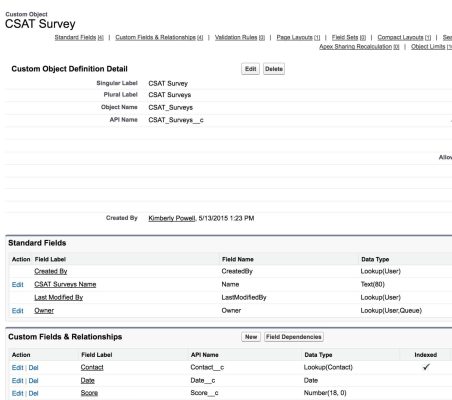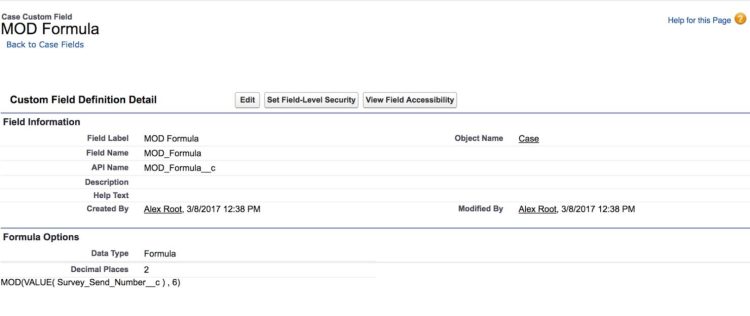GetFeedback
Salesforce Case Closed Survey Workflows
Automating your survey distribution lets you collect timely customer feedback and take action on it. You can use our Salesforce automation to send CSAT surveys after a customer interacts with your support team. We'll use a CSAT survey in this example but case closed workflows apply to other kinds of surveys like Customer Effort Score (CES) or Net Promoter Score (NPS).
Before You Start
Create the survey you want to send when someone closes a case. Keep the following in mind:
- Start with a rating question, such as a CSAT or NPS question.
- It's best to use 3-4 questions in your survey.
Create Custom Objects and Fields in Salesforce
Create a custom object in Salesforce to hold your survey responses.
When creating your custom object:
- Custom objects typically have a lookup relationship with a standard object. Lookup relationships are like a parent/child relationship between your custom survey object and any other standard or custom object in Salesforce. For example, you can create a lookup relationship between the custom CSAT Survey object and the Contact object.
- Create a custom field for each survey answer you’ll map to the object. For example, create a number field to hold the CSAT score and a text field to hold an open-text answer.
The image below shows an example of a custom CSAT Survey object:

Setting Up Salesforce Survey Mappings
In GetFeedback, create survey mappings to push responses to your custom Salesforce object. To set up mappings:
- From your survey in app.getfeedback.com, select Mappings > Salesforce Custom Mappings. Make sure to do this in draft mode.
- Connect your survey to your Salesforce environment if you haven't already.
- Select the custom Salesforce object you want to map responses to.
- For Action, select Create a new.
- Add any conditions, then select Continue.
- Finish creating your mapping. Learn more about creating custom mappings
Once you save and publish your mappings, we push any new survey responses to the Salesforce object you chose.
Adding Merge Fields to Your Survey Link
Add the Case ID merge field to your survey link to associate responses with the case. You can also add merge fields for other data you want to track.
From your survey, select Distribute > Survey link and copy your link. Then, add the Case ID merge field. Learn more about adding merge fields to survey links
Designing an Email Template in Salesforce
Your case closed survey email is the primary component of this workflow. When your support agent closes a case, the workflow sends the survey to the case contact.
There are a few ways to send a survey over email:
- Include your survey link in the body of the Salesforce email.
- Embed the first question or a call to action into Visualforce template and send it from Salesforce.
Creating a Case Closed Flow in Salesforce
Once you create your email template in Salesforce, you can build the Salesforce flow. Learn more about creating flows in Salesforce
Setting Conditions for your Case Closed Survey
If you send surveys after each case closure in Salesforce, your customers may experience survey fatigue and stop responding to surveys. You can use certain workflow rules in Salesforce to limit how often you send surveys.
For example, you can send the survey in the following conditions:
- Only for a certain number of cases (Ex.: every 6th case closed).
- Only after a period of time (Ex.: if the recipient hasn't submitted a survey in 7 days).
Only for Certain Number of Case Closures
You might want to trigger a survey for a certain number of cases only (Ex: every 4th case). To do this, you'll need to use formulas and workflow rules in Salesforce.
- Add an auto-number field to the Case object to assign each case a numeric value. This can easily be done by adding an auto-number field to the Case object that assigns each case number a numeric value of {0}.Adding an auto-number field assigns a whole number to each case.
Use a Salesforce MOD formula to return the case number to 0 whenever it is divisible by 10. The end result will be a revolving set of numbers from 1-10 that resets to 0 whenever the case number hits 10.
The screenshot below shows that formula set up for our environment. In it, the Survey_Send_Number__C field is the auto-number field we set up earlier. The 6 is the number to divide by. In this case, every 6th case will receive a survey.

2. Create a workflow rule that sends the survey when that MOD formula evaluates to zero (which will only happen every 6th case). This will be our workflow rule criteria.
Only After Certain Time Periods
You can limit how often surveys are sent to individual respondents to only send a survey after someone hasn’t completed a survey for a certain time period. To do this, use custom mappings to map the Completion Time attribute to Salesforce. The Completion Time attribute tells Salesforce when your recipient last completed a survey. Then, create a trigger in Salesforce to check the Completion Time before sending a survey.
To only send surveys after a certain time period:
- In Salesforce, create a date field on the Contact object.
- In GetFeedback, create a custom mapping to map the response attribute Completion Time to the date field on the Contact object.

3. In Salesforce, create a trigger to distribute the survey based on these rules. The trigger needs to do 3 actions:
- Check the date on the contact for the case in question
- If the date is more than a certain time period (ex: 7 days) before the current date, send the survey. Otherwise, do nothing.
- If there is no date at all, send the survey.